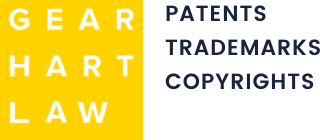Software can still be patented today, including many types of AI-based software, but it takes careful planning and a clear understanding of what the U.S. Patent and Trademark Office (USPTO) will accept. The rules have tightened in recent years, and many applications get rejected simply because they describe abstract ideas without demonstrating how the software solves a specific technical problem. If you’re working on software that uses artificial intelligence, you’ll want to be especially thoughtful in how you frame your invention.
At Gearhart Law, we help software developers, startups, and tech businesses understand what qualifies for patent protection and how to present it.
What the Law Says About Software Patents
The law doesn’t automatically block software patents, but it does require that they meet specific standards. A key rule comes from the Supreme Court’s 2014 decision in Alice Corp. v. CLS Bank, which said that software based on abstract ideas cannot be patented unless the invention clearly improves the functioning of a computer or another technology.
Here’s what that means in practice:
- Your software must do more than carry out a generic business method.
- It should solve a technical problem in a concrete way.
- A simple algorithm, by itself, is not enough.
The USPTO and courts now look for claims that show how software changes the way a system operates, not just how it automates something humans already do.
The Role of AI in Software Patentability
Artificial intelligence is changing how we think about software, but it also brings new questions about what counts as patentable. Many AI tools rely on models trained with large data sets. This process often looks abstract to a patent examiner.
That doesn’t mean AI inventions are unpatentable. In fact, many are, but you must be clear about how your AI tool functions and what technical benefit it provides. For example:
- An AI system that reduces latency in a wireless network
- A machine learning model that detects credit card fraud more accurately
- A software tool that improves image clarity in diagnostic imaging
In each case, the software is doing something more than just analyzing data—it’s improving a process or solving a specific technical problem.
Challenges You May Face With AI-Related Software
Even strong software inventions can encounter difficulties during the patent process. Here are a few common issues:
- Abstract rejections: The examiner may claim your invention is too theoretical or math-based.
- Lack of technical detail: If your application doesn’t explain exactly how the invention works, it may be rejected.
- Overly broad claims: Broad or vague descriptions may trigger rejections or limit enforceability later.
You’ll also face more scrutiny if your software uses AI methods that are already widely known. The key is showing how your version adds something new and specific.
Strategies to Strengthen Your AI or Software Patent Application
To improve your chances of approval, it helps to take a strategic approach to how you describe your invention. That includes:
- Showing how your software solves a technical problem, not just a business one
- Describing the inputs, processing steps, and outputs clearly
- Using examples or diagrams to explain how the invention works
- Avoiding buzzwords and sticking to technical accuracy
At Gearhart Law, we work with clients to shape patent applications that address examiner concerns before they come up. The more precise you are in your application, the stronger your patent will be.
How Gearhart Law Can Help
We’ve helped software developers across New Jersey and beyond protect innovations in artificial intelligence, machine learning, cloud computing, and more. When you work with us, we:
- Review your invention and assess its patent eligibility
- Prepare and file clear, focused patent applications
- Respond to examiner feedback during the process
- Help you build a patent portfolio that aligns with your business goals
Whether you’re filing your first application or growing your IP assets, we’re here to guide you with practical, informed advice.
Next Steps for Protecting Your Software Innovation
Patents are still available for software even in the age of AI, but the process demands clarity and strategy. If you’re developing an innovative software solution, we’ll help you figure out what’s worth protecting and how to do it effectively.
Contact Gearhart Law today to schedule a consultation and take the next step toward protecting your work.

